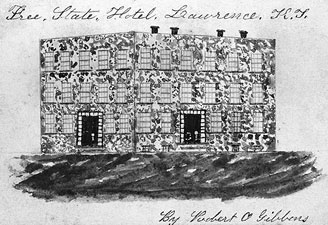talking history | syllabi | students | teachers | puzzle | about us
Territorial Kansas Online, 1854–1861
http://www.territorialkansasonline.org
Created and maintained by the Kansas State Historical Society and the Kansas Collection of the University of Kansas.
Visited Sept. 4–9, 2004.
The Territorial Kansas Online, 1854–1861 Web site bills itself as a “virtual repository.” Spare in their own interpretations of “bleeding Kansas,” the Web site’s authors have chosen to offer a vast array of primary sources, drawn mostly from the Kansas State Historical Society and the Kansas Collection of the University of Kansas, and let readers come to their own conclusions about the material. The site is a wonderful resource for teachers and professors as well as for researchers in the field.
The Web site’s strength is the number of primary sources that it makes available. Its creators have given visitors several ways to search through this information. The easiest to use is the Topics sidebar, which offers five choices: Territorial Politics & Government; Border Warfare; Immigration and Early Settlement; Personalities; and National Debate about Kansas. Other topics, such as Women, Slavery, and Native Americans, could well be added to offer other ways to approach the Kansas experience. Other sidebars include timelines, lesson plans, an excellent bibliography with hot links to many of the works listed, historic places, and links to related sites.

Besides photographs of well-known figures such as John Brown,
the “Territorial Kansas Online” site features obscure but informative
illustrations such as this painting of the Free State Hotel,
destroyed in the sack of Lawrence in 1856.
(Kansas State Historical Society collection)
While it is impossible to give a complete overview of the virtual repository, some examples will convey the generous scope of the site. A convenient search-by-county feature can help researchers interested in a particular place. A search of Atchison County detected eleven photographs and thirty-two documents. The documents include letters from politicians such as S. C. Pomeroy as well as ones from such ordinary settlers as E. Whitney writing to her father about the sack of Lawrence. Also included are an 1858 poll book and all forty-three pages of the county’s 1855 census. A different search starting at the Topics heading Border Warfare turns up four topical subheadings (each with as many as ninety-three items) and fourteen chronological subheadings. From there, choosing Pottawatomie Massacre brings up seven items, including a diary, court testimony, and several letters. Best of all, documents always appear in their entirety and in manuscript form, adding to the site’s archival feel.
Another search further reveals the Web site’s archival richness but also its largest weakness. Clicking on Julia Lovejoy from the Personalities heading yields a brief biographical sketch, a photograph, and, most impressive, all twenty-nine pages of her 1850s diary. Missing, however, are Lovejoy’s many letters, reprinted in the 1940s by the Kansas Historical Quarterly. If you know to look for them, you can find them in the Bibliography section, complete with a hot link to a full transcription of them. The Bibliography section is not searchable, however, and this masks some of the site’s richness, including books by Hannah Ropes and Sara Robinson. The Web site’s creators deserve much credit for making these books and many secondary articles available, but we can hope they become easier to locate.
Territorial Kansas Online will be a great help to researchers, though the authors note that the two archives “hold additional materials.” Professors could use it for historical methods classes as well as Civil War courses. For grades 6 to 8, lesson plans grouped around smaller numbers of documents will allow students to explore history and to create their own interpretations.
Michael D. Pierson
University of Massachusetts
Lowell, Massachusetts
